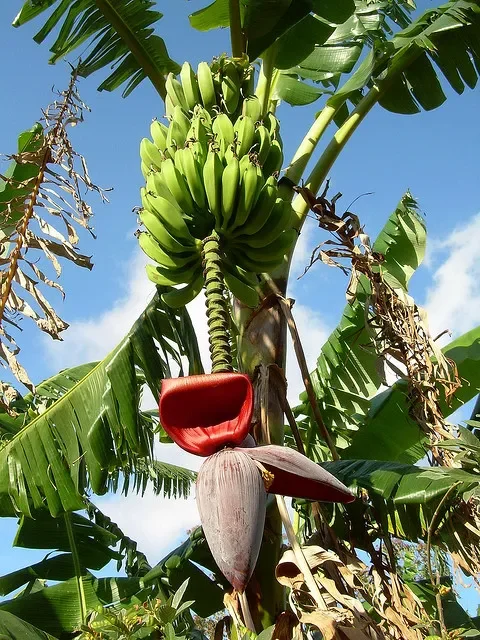Matooke(Banana)
Matoke, locally also known as matooke, amatooke in Buganda (Central Uganda), ekitookye in southwestern Uganda, ekitooke in western Uganda, kamatore in Lugisu (Eastern Uganda),
Cooking bananas have long been and still are a common staple crop around the Lake Victoria area of Kenya and Uganda, and in the West and Kilimanjaro regions of Tanzania.
In Uganda, East African Highland bananas are easily distinguishable from other banana cultivars by the numerous black (or more rarely brown or bronze) blotches on their pseudostems, giving them the appearance of polished metal. The outermost sheath of their pseudostems is a medium green, superimposed over the pink to purple underlying sheaths.
Their leaves are also darker green and dull, a difference more apparent when comparing them side by side with other banana cultivars from a distance.
The inflorescence has peduncles covered with coarse hair. The bracts are ovate to lanceolate in shape with outer surfaces that are purple to brown and inner surfaces which are red fading to yellow towards the base. The male flowers have cream colored tepals with yellow lobes. The anthers are pink, while the stigmata are orange.
The fruits are recurved and can vary in length. They are inflated with blunt tips. The pulp is white in unripe fruits and cream-colored in ripe fruits.
Bananas are a subgroup that refers to about 200 individual banana cultivars (or clones). They can be subdivided into five distinct groups of clones known as clone sets:
Mbidde or beer clone set
The Mbidde clone set contains 14 cultivars. Mbidde means 'beer', and clones belonging to this clone set are usually used for making banana beer.Their pulp is bitter and astringent with sticky brown excretions.
Nakitembe clone set
Nakabululu clone set
Nakabululu clones are soft-textured and savory. They mature quickly, but their fruits are smaller and have lesser overall yields per bunch.
Musakala clone set
Musakala clones are characterized by slender fruits with bottle-necked tips. Other characteristics are the same as the preceding three clone sets.
Nfuuka clone set
Nfuuka clones are characterized by inflated, rounded, or almost rectangular fruits with intermediate-shaped tips. The bunch shape is mainly rectangular. Other characteristics are the same as the other clone sets. It is the most diverse of the five clone sets, a probable result of its tendency to mutate more frequently. They bear heavy compacted bunches and are thus more often exploited commercially than other clone sets.
THE MAKING OF LOCAL BEER OUT OF MBIDDE CLONE
East African Highland bananas were introduced early into Africa from Southeast Asia during the first to sixth centuries AD, probably via trade. They are genetically distinct from the other AAA cultivars, having evolved locally in the African Great Lakes region for over a millennium. They are found nowhere else in the world, and the African Great Lakes has been called the secondary center of banana diversity because of this (with Southeast Asia being the first). East African Highland bananas are considered to be especially diverse in Uganda, However, genetic analysis has revealed that all East African Highland bananas are genetically uniform, having most likely originated from a single ancestral clone (introduced to Africa within the past 2000 years) that underwent population expansion by vegetative propagation.
The triploid East African Highland banana gene pool arose from a single hybridization event, which generated a genetic bottleneck during the foundation of the crop genepool. Triploid East African Highland bananas are sterile, and have been asexually vegetatively propagated for generations by successive generations of farmers since their introduction to Africa. This has likely led to the emergence of the genetically near-isogenic somatic mutants (i.e. today's East African Highland banana varieties) that have been selected by farmers and environments across East Africa
In the Buganda Kingdom, bananas, particularly the East African Highland banana (also known as matooke), are a staple food and a significant part of the culture. They are not just a food source but deeply embedded in cultural practices, traditions, and even social structures.
Here's a more detailed look at the role of bananas in Buganda:
1. Staple Food:
Matooke is the primary starchy food in Buganda and is considered a national dish.
It's typically harvested green, peeled, steamed, mashed, and then steamed again before being served.
In Buganda, any meal is often considered incomplete without matooke.
Different varieties of matooke are used for eating as steamed food, ripe bananas, brewing, and snacks.
2. Cultural Significance:
The banana plant, especially matooke, is cherished and holds deep cultural significance.
Traditions surrounding banana cultivation and consumption are passed down through generations.
For example, the placenta of a newborn is traditionally placed under a specific type of matooke plant, symbolizing a sibling relationship with the banana plant.
The banana is more than just a plant or a food; it's an integral part of Buganda's identity and heritage.
3. Economic Importance:
Banana cultivation is a significant part of the agricultural economy in Buganda.
The crop provides various products, including the fruit (matooke), banana fiber (kyayi), banana stem (kigoogo), and peels (bikuta).
Banana production contributes to the livelihoods of many families in the region.
In the past, rulers like King Ssemakookiro even decreed that women neglect their banana plantations, highlighting its importance.
4. Historical Context:
Banana cultivation in Buganda is believed to have been introduced centuries ago, possibly during the reign of King Kintu.
Over time, it has become deeply rooted in the culture and economy of the kingdom.
Historical accounts mention that even early European travelers noted the prevalence of banana plantations in Buganda.
In essence, the banana in Buganda is a multifaceted entity, encompassing not just sustenance but also tradition, culture, and economic activity.











